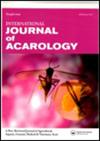昆虫病原冬虫夏草(Cordyceps tenupes, Kepler, B. Shrestha et Spatafora)对刺叶螨的防效研究
IF 1
3区 农林科学
Q3 ENTOMOLOGY
引用次数: 0
摘要
刺叶螨(螨亚纲:叶螨科)是一种广泛寄生于多种植物的蜘蛛螨。由于它能够迅速对普通杀虫剂产生抗性,因此很难控制。研究相对湿度(55、75和95±2% RH)对昆虫病原冬虫夏草(1 × 106、1 × 107和1 × 108孢子/ml)对piercei虫卵期和成虫期的影响。结果表明,刺青弓形虫卵的死亡率呈浓度依赖性,RH对效果有协同效应。在相同RH条件下,卵死亡率随浓度的增加而增加,在1 × 106 ~ 1 × 108孢子/ml, 95% RH条件下,1 × 108孢子/ml显著高于75和55% RH条件下。1 × 108个分生孢子/ml浓度处理下,95% RH下成虫致死时间(LT50)为41.1 h, 75% RH下为49.8 h。这明显低于其他相对湿度水平和浓度下的LT50值。盆栽试验结果表明,在1 × 108分生孢子/ml浓度下,双喷可有效防治刺螟。单次喷淋后,螨的数量呈先减少后增加的趋势。因此,在使用生物防治方法有效防治该害虫时,考虑RH并结合其他策略是重要的。本文章由计算机程序翻译,如有差异,请以英文原文为准。
Efficacy of entomopathogen Cordyceps tenuipes (Peck) Kepler, B. Shrestha et Spatafora against spider mite Tetranychus piercei McGregor (Acari: Tetranychidae)
ABSTRACT Tetranychus piercei (Acari: Tetranychidae) is a spider mite that infests a wide range of plants. It is difficult to control due to its ability to quickly develop resistance to common pesticides. The study aimed to find the effect of relative humidity (55, 75, and 95 ± 2% RH) on the efficacy of the entomopathogen Cordyceps tenuipes (1 × 106, 1 × 107 and 1 × 108 conidia/ml) against the egg and adult female stages of T. piercei. The results showed that the mortality of T. piercei eggs was concentration-dependent and that RH has a synergistic effect on efficacy. The egg mortality increased with the increasing the concentration from 1 × 106 to 1 × 108 conidia/ml at the same RH condition, and it was significantly higher at 1 × 108 conidia/ml at 95% RH than at 75 and 55% RHs. The median lethal time (LT50) for adult females was 41.1 hours at 95% RH and 49.8 hours at 75% RH when treated with a concentration of 1 × 108 conidia/ml. This was significantly lower than the LT50 values at other relative humidity levels and concentrations. The results of the study on potted bean plants showed that double spray of C. tenuipes was effective in controlling T. piercei infestations at a concentration of 1 × 108 conidia/ml. With a single spray of C. tenuipes, the mite population tends to be reduced initially and then increased subsequently. Thus, considering RH and incorporating other strategies is important when using biological control methods to effectively control this pest.
求助全文
通过发布文献求助,成功后即可免费获取论文全文。
去求助
来源期刊
CiteScore
2.20
自引率
9.10%
发文量
60
审稿时长
6-12 weeks
期刊介绍:
The International Journal of Acarology has a global readership and publishes original research and review papers on a wide variety of acarological subjects including:
• mite and tick behavior
• biochemistry
• biology
• control
• ecology
• evolution
• morphology
• physiology
• systematics
• taxonomy (single species descriptions are discouraged unless accompanied by additional new information on ecology, biology, systematics, etc.)
All submitted manuscripts are subject to initial appraisal by the Editor. If the English is not of a quality suitable for reviewers, the manuscript will be returned. If found suitable for further consideration, it will be submitted to peer review by independent, anonymous expert referees. All peer review is single blind.

 求助内容:
求助内容: 应助结果提醒方式:
应助结果提醒方式:


